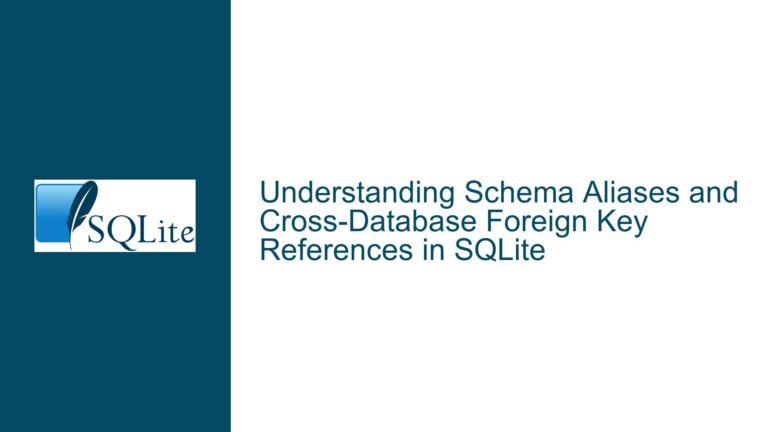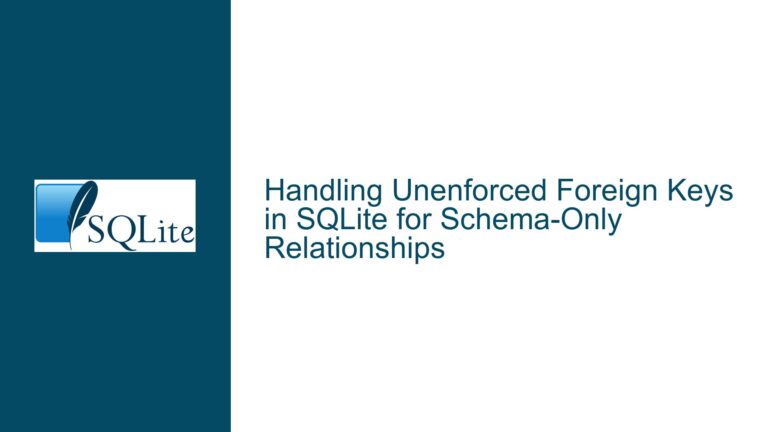Read-Only WAL Connections Require Write Permissions for SHM/WAL Files
Understanding SQLite WAL Mode and Read-Only Connection Requirements
Issue Overview: Read-Only Connections in WAL Mode and File System Permissions
SQLite’s Write-Ahead Logging (WAL) mode introduces unique file system requirements compared to traditional rollback journal modes. A critical question arises: Can a process with read-only file system permissions reliably access a WAL-mode database while preserving snapshot isolation, even when concurrent writers are active? The answer hinges on how SQLite manages the -wal (Write-Ahead Log) and -shm (Shared Memory) files, which are essential for WAL operation.
Key Technical Dynamics:
WAL File Mechanics:
In WAL mode, writers append changes to the-walfile instead of modifying the main database file directly. Readers use the-walfile to reconstruct a consistent snapshot of the database. The-shmfile acts as a shared-memory index to coordinate access to the-walfile across processes.- A checkpoint operation transfers changes from the
-walfile to the main database file. - Long-running read transactions block checkpoints to maintain snapshot consistency.
- A checkpoint operation transfers changes from the
Read-Only Connections and Locking:
A read-only connection in SQLite (opened withSQLITE_OPEN_READONLY) does not modify the database. However, in WAL mode, such connections still interact with the-shmfile to coordinate locks and track active readers. Specifically:- Readers acquire shared locks on the database to signal their presence to writers.
- The
-shmfile contains metadata about active readers, which writers use to determine when checkpoints are safe.
File System Permissions vs. SQLite Semantics:
Even if a connection is logically read-only (noINSERT,UPDATE, etc.), SQLite may still require physical write access to the directory containing the database. This is because:- The
-shmfile must be writable to update reader counters and lock states. - If the
-walor-shmfiles are missing, SQLite may attempt to create them when opening the database, which requires write permissions.
- The
Core Conflict:
A read-only process without write permissions cannot create or modify the -shm file. If these files are already present (e.g., created by a prior writer), the read-only process may function. However, if the files are missing or truncated, the connection will fail. This creates a dependency: readers in WAL mode require the -wal and -shm files to exist before opening the database, which may necessitate write permissions during initialization.
Possible Causes: Why Read-Only WAL Connections Fail Without Write Permissions
1. Missing -wal or -shm Files
When a read-only connection opens a WAL-mode database:
- SQLite checks for the presence of the
-waland-shmfiles. If they are missing, it attempts to create them. - Failure: If the process lacks write permissions, file creation fails, and the connection is aborted.
Example Scenario:
A database is converted to WAL mode by a writer process. Later, a read-only user attempts to open the database after the writer has closed it and deleted the -wal/-shm files (via sqlite3_close with checkpointing). The read-only user cannot recreate these files, leading to an error.
2. Inadequate Locking Mechanism Permissions
The -shm file uses byte-range locks to coordinate readers and writers. On Unix-like systems:
- flock()/fcntl() Behavior: Read locks (shared) on the
-shmfile do not require write permissions. However, SQLite’s default VFS (virtual file system) may still attempt to write to the-shmfile to update reader counters. - File System Compatibility: On systems where locking relies on file modifications (e.g., some networked file systems), write permissions may be implicitly required even for read locks.
3. Checkpoint Blocking Without -shm Coordination
A read-only connection without access to the -shm file cannot update its reader state. Writers may proceed with checkpoints prematurely, violating snapshot isolation. This results in:
- Data Inconsistency: Readers might observe partial writes if checkpoints proceed while they are active.
- Silent Corruption: In extreme cases, a checkpoint could truncate the
-walfile while a reader is using it, leading to crashes or undefined behavior.
Resolving Read-Only WAL Access: Solutions and Configuration
1. Pre-Create -wal and -shm Files
Ensure the auxiliary files exist before read-only connections are opened:
- Persistent WAL Mode: Use
PRAGMA journal_mode=WAL;followed bysqlite3_file_control(SQLITE_FCNTL_PERSIST_WAL, 1). This prevents SQLite from deleting the-waland-shmfiles on connection close.// C API example sqlite3_open("database.db", &db); sqlite3_file_control(db, "main", SQLITE_FCNTL_PERSIST_WAL, (void*)1); - File System Permissions: Set directory permissions to allow writers to create
-wal/-shmfiles, but restrict write access to the main database file if needed.
2. Immutable Database Configuration
For truly read-only databases (no writers), mark the database as immutable:
- Query Parameter: Append
?immutable=1to the database URI.sqlite3_open_v2("file:database.db?immutable=1", &db, SQLITE_OPEN_READONLY, NULL); - Effect: SQLite skips all checks for
-wal/-shmfiles and assumes no writes will occur. Use this only if the database is guaranteed not to change.
3. Custom VFS for Locking Without Write Access
Modify SQLite’s locking behavior to avoid -shm file writes:
- Alternative Locking Mechanisms: Implement a custom VFS that uses named semaphores or in-memory structures for reader tracking.
- Risks: This approach is complex and may introduce platform-specific dependencies.
4. Directory and File Ownership
Ensure read-only users have execute permissions on the directory (to traverse it) and read permissions on all files:
chmod a+rX /path/to/db_directory
chmod a+r database.db database-wal database-shm
Note: Write permissions on the directory are not required if -wal/-shm files already exist.
5. Monitoring and Maintenance
- Checkpoint Scheduling: Use
PRAGMA wal_checkpoint(TRUNCATE)during maintenance windows to minimize-walfile size. - File Existence Checks: Implement a watchdog process to recreate
-wal/-shmfiles if they are deleted unexpectedly.
Final Recommendations:
- Use
SQLITE_FCNTL_PERSIST_WALto keep-wal/-shmfiles permanently. - Grant read-only users read access to all database files and execute access to the directory.
- Avoid
SQLITE_OPEN_READONLYfor WAL databases unless auxiliary files are guaranteed to exist. - For immutable databases, use the
immutableparameter to bypass WAL checks entirely.
By addressing these factors, read-only processes can reliably access WAL-mode databases without requiring write permissions, provided the auxiliary files are managed correctly.






